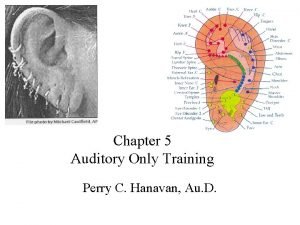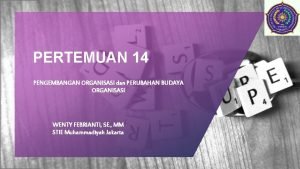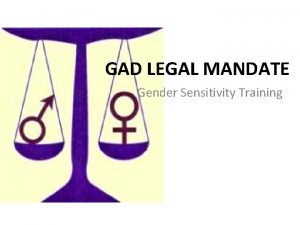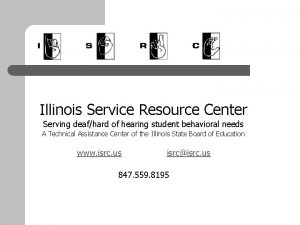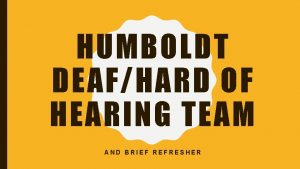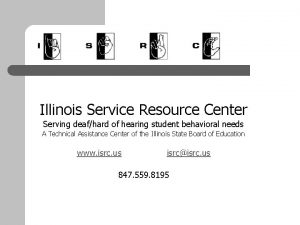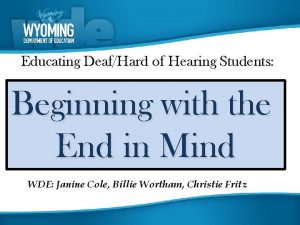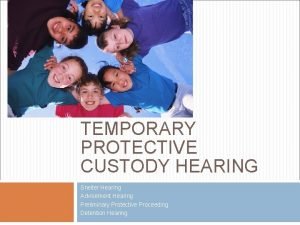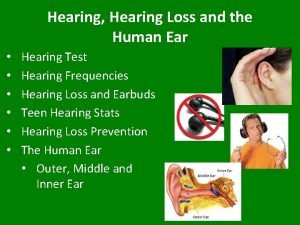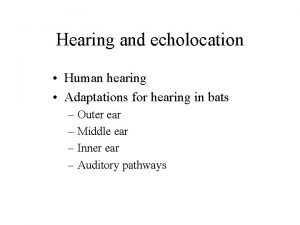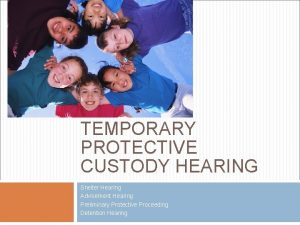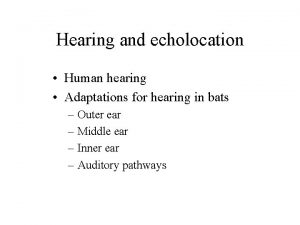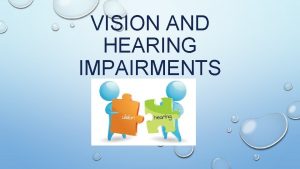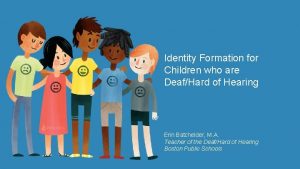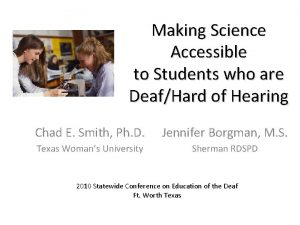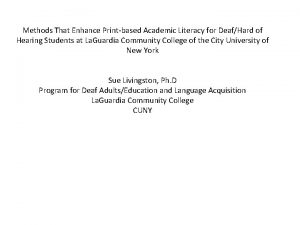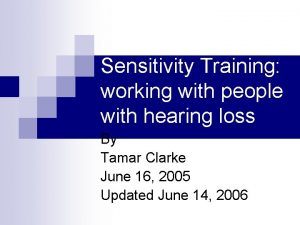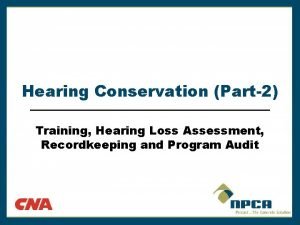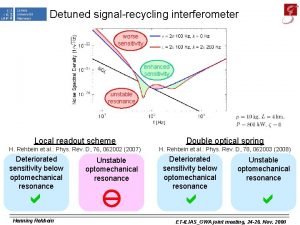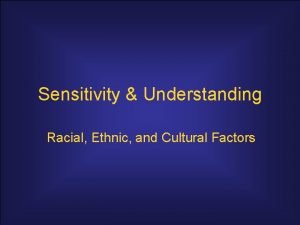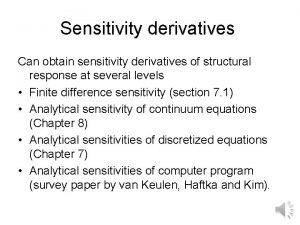DeafHard of Hearing Sensitivity Training for 9 1



























- Slides: 27

Deaf/Hard of Hearing Sensitivity Training for 9 -1 -1 Personnel Prepared by the Office for Deaf and Hard of Hearing Services (DHHS) of the Texas Department of Assistive and Rehabilitative Services/Division for Rehabilitation Services, Austin Presented by: Alma Bebee- Deafness Resource Specialist

Why are we here? TTY/TDD User Sensitivity Training for 9 -1 -1 Personnel

Demographics n 8. 8 per cent of the general population has a hearing loss sufficient enough to need ongoing services (not hearing aid only) n 6. 5 of the above are categorized as hard of hearing or late-deafened n 2. 3 of the above number are members of the Deaf or deaf community n the numbers are greater in rural areas and areas of lower socio-economic resources

ADA n Americans with Disabilities Act n Title II, Section 35. 162 n telephone emergency services shall provide direct access to individuals who use TTY’s and computer modems. . .

Parts of the ADA n. I Employment n n II any entity employing 15 or more persons State and local government n III Public Accommodations n IV Telecommunications n V Miscellaneous

Hearing Loss Categories n Deaf - note the capital “D, ” persons who are involved mainly within the Deaf community/Deaf Culture and are native ASL users. n deaf - persons who have little useable residual hearing and depend on visual communication as their main mode for communication n hard of hearing - persons with useable residual hearing which may be assisted with amplification n late deafened - persons, who as an adult, has lost most of their hearing as a result of an injury, illness or as part of the aging process.

Why it might be difficult to learn English, especially if you don’t hear it: The bandage was wound around the wound. The farm was used to produce We must polish the Polish furniture Since there is no time like the present; he thought it was time to present the present. A bass was painted on the head of the bass drum. They were too close to the door to close it. The buck does funny things when the does are present. After a number of injections my jaw finally got number. Upon seeing the tear in the painting, I shed a tear. I had to subject the subject to a series of tests. The soldier decided to desert his dessert in the desert.

Communication Methods v Sign Language: Linguistic research has shown many sign languages, American Sign Language is one, have their own grammatical structures, syntax, rules, etc. like spoken languages. v Universality: Sign languages are not universal. Like spoken languages, sign languages around the world are entirely different. ASL is primarily used in America and Canada. However, fluent sign language users do have advantages over spoken languages users. The monolingual signer can communicate with other foreign signers much easier, using gestures, body language and pictorial expressions than monolingual (spoken) persons in a foreign country. v American Sign Language (ASL): ASL is not an abbreviated form of English nor is it a simplified version. It is the native language most persons who are Deaf in America uses.

Communication Methods (continuation): v Home Signs: In some very rural areas, deaf children and their family members use home signs when they are not exposed to any other people who are deaf or the Deaf community. v Oral/Aural: v Oral is where the child is taught to use their speech and speechreading abilities. Age of onset, identification/amplification onset, severity of loss all play an important role in the level of success. v Speech-reading or lip-reading is an innate ability. A person (deaf or hearing) is either born with the ability to do so or is not born with the ability to do so. You can improve the skill for someone with the innate ability but you cannot teach someone born without. v Sign Systems: a combination of signs used in English word order, which sign the word and not the meaning used mostly in educational settings to help improve English proficiency

Communication Methods (continuation): v Oftentimes, many years of trying to teach (improve) the ability passes before it is realized that the child will not succeed with the chosen method. Much information can be lost during these formative years. v The most proficient of speech-readers can only catch about 25% of a known topic/conversation. This lessens to about 15% when the topic of conversation is unknown as the context on which to base one’s guesses is lowered. Many English sounds look alike on the lips and many words look alike on the lips. The anatomy of the speaker and the environment influence the “read-ability” - thin lips are difficult to read, as are the lips of someone with a full beard/moustache , it is most difficult to read some who is writing on a blackboard (school settings) and extremely difficult to follow the subject matter on films that has voice-overs (speaker is not presented on the screen) or includes animation. v Aural is where the child is taught to use what residual hearing (amplified or not) they may have to their best benefit. Some schools advertise that they “teach deaf children to hear. ”

Communicating with Individuals who are Hard of Hearing/Oral Deaf n Slow down a bit n Numbers: 50 and 15 or n Don’t yell, this distorts 50 and 60 sound much alike n Say 50, five/zero or 15, one/five for example n Be patient your words n Rephrase statement or question n If you must spell, say: “B” as in baseball, etc.

The Manual Alphabet -one of the few commonalties in the numerous sign systems in use in America Practice fingerspelling your name.

Cultural Behaviors - Deaf/Hearing * Getting Attention * Flickering of lights or stomping on wooden floor vs calling, “Hey” * Party * Staying in the kitchen where there is more lighting vs the living room * Introductions * Long introductions with questions vs “Nice to meet you * Pointing * Considered necessary vs considered rude

TTY/VP Users n Persons who are culturally Deaf n Persons who are deaf n Persons who are hard of hearing n Persons who are late-deafened n Persons who are speech impaired n Others? ? ?

TTY /VP Related Words/Definitions n Relay service - telephone relay service allowing persons who have a TTY to call persons who do not and vice-versa n Direct access- the ability to directly receive a call without third party services n Baudot - code used by TTYs n ASCII - American Standard Code for Information Interchange: code used by computers and facsimile machines

Devices used by persons who are deaf/hard of hearing: l Telephones: TTY Ø Amplified phone Ø Pay Phone with TTY Ø Pay Phone w/amplifier Ø Video Phone ● Hearing aids, cochlear implants, digital hearing aids, assistive listening devices Ø l Pager ØDigital ØText ØWireless 2 -way

Types of TTYs n Acoustic (telephone receiver must rest in TTY coupler) n Direct Connect (telephone line plugs into TTY and separate phone implement is not necessary – “dial” from the keyboard) n Acoustic/Direct Connect - some have either/or capabilities

Types of TTY Calls n Traditional n VCO (Voice Carry Over) n HCO (Hearing Carry Over) n TTY via relay service n VCO via relay service n HCO via relay service

Types of TTY Calls n VCO (Voice Carry Over) n User has intelligible speech and prefers to speak instead of type to you. n faster than traditional TTY call; n popular with persons who are latedeafened and hard of hearing - typing speed is slow due to age/arthritis and/or never using a keyboard previously.

Is this call a TTY/TDD call? n Electronic tones n do not sound like a fax but is often confused and hung-up on or transferred to fax machine n Silence (open line) n older machines and older users do not “key-in” to alert you the call is from a TTY/TDD n Synthesized voice announcement n many newer machines have this option (will not be recognized by your PSAP - TDD Challenge button) n Relay agent n no need to activate the TDD Challenge or get your TTY/TDD

TTY Abbreviations n GA - go ahead n MSG - message n SK - stop keying n CUD - could n GA to SK - I’m ready to n B 4 - before n n hang up, are you? SKSK - hanging up Q - Question mark xxx - error CUL - see you later n U - you n Pls - please n NUM - number n R - are n Many, many others

Relay Texas n Relay service mandated by ADA under Title IV, however, Relay Texas opened prior to ADA mandate n Enables person with TTY to call person/business who does not and viceversa n Free service that is available 24 hours a day, 365 days a year n 7 -1 -1

New technology/Culture Changes n Video Phones n VOIP n Video Relay Services n Internet Relay Services

Technology and Relay Updates n IP Relay Service n 10 digit number- need to register with Online Relay Provider n Internet based, so therefore no ANI/ALI, providers are nationwide and your relay agent may be several states away and unfamiliar with regional/slang terms n Video Relay Service n 10 digit number-need to register with VRS provider n Although communication is much smoother and quicker because the person is using their primary language with which to communicate, the same problems as above are present n Cap. Tel Relay Service n This phone/service uses voice recognition software. When the caller dials a number, the phone automatically routes the call first through a Cap. Tel transcription center. There, everything you say is restated since software must learn to understand the speaker) which in turn becomes text for the caller. HOWEVER, when a Cap. Tel phone dials 9 -1 -1, it automatically becomes a VCO phone and bypasses the Cap. Tel transcription center. You will handle this as a VCO call.

Video Relay Phone Booth TTY Accesible

Relay Protocol n Immediately verify address and phone number with the caller n Speak in “first-party” language n Don’t solicit opinion or comment from the agent, operator or communication assistant n Do handle the call just as you would any other but add a ‘GA’ or ‘SK’

Thank you n Questions n Feedbacks n Contact information: 361 -334 -5826 - V/TTY 866 -993 -1154 - Toll Free 866 -757 -3350 - Video phone
 Clearworks audiology
Clearworks audiology Model perubahan budaya organisasi
Model perubahan budaya organisasi Gender sensitivity training topics
Gender sensitivity training topics Fspos
Fspos Typiska novell drag
Typiska novell drag Tack för att ni lyssnade bild
Tack för att ni lyssnade bild Vad står k.r.å.k.a.n för
Vad står k.r.å.k.a.n för Varför kallas perioden 1918-1939 för mellankrigstiden
Varför kallas perioden 1918-1939 för mellankrigstiden En lathund för arbete med kontinuitetshantering
En lathund för arbete med kontinuitetshantering Underlag för särskild löneskatt på pensionskostnader
Underlag för särskild löneskatt på pensionskostnader Personlig tidbok
Personlig tidbok Sura för anatom
Sura för anatom Vad är densitet
Vad är densitet Datorkunskap för nybörjare
Datorkunskap för nybörjare Tack för att ni lyssnade bild
Tack för att ni lyssnade bild Debatt mall
Debatt mall För och nackdelar med firo
För och nackdelar med firo Nyckelkompetenser för livslångt lärande
Nyckelkompetenser för livslångt lärande Påbyggnader för flakfordon
Påbyggnader för flakfordon Lufttryck formel
Lufttryck formel Publik sektor
Publik sektor Kyssande vind
Kyssande vind Presentera för publik crossboss
Presentera för publik crossboss Teckenspråk minoritetsspråk argument
Teckenspråk minoritetsspråk argument Plats för toran ark
Plats för toran ark Klassificeringsstruktur för kommunala verksamheter
Klassificeringsstruktur för kommunala verksamheter Luftstrupen för medicinare
Luftstrupen för medicinare Bästa kameran för astrofoto
Bästa kameran för astrofoto
